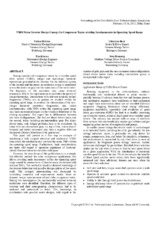| dc.description.abstract | During operation of compressor trains by a variable speed
drive system (VSDS), integer and non-integer harmonic
currents are generated in the inverter. Via the electrical system
of the inverter and the motor, an excitation torque is transferred
across the motor air gap into the main mass of the motor rotor.
The frequency of this excitation may cause torsional
resonances. Due to the rapid increase in excitation frequency of
integer harmonics, intersections with relevant torsional natural
frequencies (TNFs) can in general be avoided within the
operating speed range. In contrast, the intersections of the noninteger
harmonic excitation frequencies, also called
interharmonics, with TNFs within the operating speed range
may have an essential impact on the vibration behaviour of the
rotating equipment. This aspect has to differentiate between
two train configurations. The first are direct driven trains and
the second, trains including an intermediate gear. For direct
driven trains, only fatigue problems have to be considered. In
trains with an intermediate gear, on top of that, interaction of
torsional and lateral movement may have a negative effect on
the lateral vibration behaviour of the gear rotors.
This paper will present as a first step an example of
simulating a fully coupled electrical and mechanical VSDS
train where the interharmonics intersect the main TNFs within
the operating speed range. Furthermore, basic considerations
are made with regard to operation experience of torsional/
lateral vibration interaction in trains with gears.
However, the main focus of this publication is on a simple
but effective method for turbo compressor applications that
allows avoiding main resonances within the operating speed
range caused by intersections of interharmonic excitations with
relevant TNFs. This method is based on detailed knowledge of
the inverter behaviour and possible design options of the motor
itself. This in-depth understanding was developed by
correlating numerical and experimental results based on
dynamic torque measurements of real turbo compressor trains.
During this investigation the mechanically relevant torsional
excitations were identified. Therefore, the different types of
inverters and their corresponding characteristics had to be
analyzed and understood in detail. This knowledge, in
combination with possible motor designs, with regard to the
number of pole pairs and the most common train configurations
(direct driven and/or trains including intermediate gears), is
incorporated in this report. | en |


